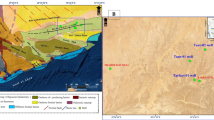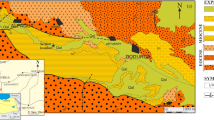Abstract
This paper demonstrates how stable carbon isotopes can be utilized to identify the source of oil-based drill cuttings discharges and estimate the time of their deposition. The base-oil used in drilling mud systems may be biodegraded by seabed microflora. Effects of such processes make it difficult to identify sources of discharges based on the oil’s molecular structure. However, the stable isotope fingerprint of the base oil may vary for each batch of base-oil. Because carbon isotopic ratios in compounds with more than ten carbons are resistant to fractionation during biodegradation, this may be used as a tool to identify the source of drill cuttings discharges.





Similar content being viewed by others
References
Artz R, Semple K, Kilham K, Prosser JI, Paton GI (2002) The potential for anaerobic mineralisation of hydrocarbon constituents of oily drill cuttings from the North Sea seabed. J Environ Monit 4:553–557. doi:10.1039/b203991p
Benson S, Lennard C, Maynard P, Roux C (2006) Forensic applications of isotope ratio mass spectrometry—a review. Forensic Sci Int 157:1–22. doi:10.1016/j.forsciint.2005.03.012
Bilstad T, Boasdal T, Toerning E (1987) Biodegradation of oil on drilled cuttings. Water Sci Technol 19:355–369
Hoefs J (1997) Stable isotope geochemistry, 4th edn. Springer, Berlin
Meckenstock RU, Morasch B, Griebler C, Richnow HH (2004) Stable isotope fractionation analysis as a tool to monitor biodegradation in contaminated acquifers. J Contam Hydrol 75:215–255. doi:10.1016/j.jconhyd.2004.06.003
Jovancicevic B, Tasic L, Wehner H, Faber E, Susic N, Polic P (1997) Identification of oil-type pollution in recent sediments. Fresenius Environ Bull 6:667–673
Jovancicevic B, Vrvic M, Schwarzbauer J, Wehner H, Scheeder G, Vitorovic D (2007) Organic-geochemical differentiation of petroleum-type pollutants and study of their fate in Danube alluvial sediments and corresponding water (Pancevo Oil Refinery, Serbia). Water Air Soil Pollut 183:225–238. doi:10.1007/s11270-007-9371-7
Peters KE, Walters CC, Moldowan JM (2005). The biomarker guide. vol 2. Biomarkers and isotopes in petroleum exploration and earth history, 2nd edn. Cambridge University Press, Cambridge, UK
Philp R (2007) The emergence of stable isotopes in environmental and forensic geochemistry studies: a review. Environ Chem Lett 5:57–66. doi:10.1007/s10311-006-0081-y
Skaare BB, Wilkes H, Vieth A, Rein E, Barth T (2007) Alteration of crude oils from the troll area by biodegradation: analysis of oil and water samples. Org Geochem 38:1865–1883. doi:10.1016/j.orggeochem.2007.07.007
Vieth A, Wilkes H (2006) Deciphering biodegradation effects on light hydrocarbons in crude oils using their stable carbon isotopic composition: a case study from the Gullfaks oil field, offshore Norway. Geochim Cosmochim Acta 70:651–665. doi:10.1016/j.gca.2005.08.022
Weiss HM, Wilhelms A, et al (2000). NIGOGA—The Norwegian industry guide to organic geochemical analyses [online], Norsk Hydro, Statoil, Geolab Nor, SINTEF Petroleum Research and the Norwegian Petroleum Directorate.: 102 pp
Wenger LM, Davis CL, Isaksen G (2001) Multiple controls on petroleum biodegradation and impact on oil quality. SPE Reservoir Eval Eng 5:375–383
Wenger LM, Davis CL, Evensen JM, Gormly JR, Mankiewicz PJ (2004) Impact of modern deepwater drilling and testing fluids ongeochemical evaluations. Org Geochem 35:1527–1536. doi:10.1016/j.orggeochem.2004.07.001
Widdel F, Boetius A, Rabus R (2006). Anaerobic biodegradation of hydrocarbons including methane, In: Dworkin M, Falkow S, Rosenberg E, Schleifer K–H (eds). The Prokaryotes. vol 2: Ecophysiology and biochemistry. Springer, New York. 2:1028–1049
Acknowledgments
Frode Uriansrud (StatoilHydro) is thanked for providing valuable background information and StatoilHydro is acknowledged for funding this study. Dr. Ian Allan is thanked valuable improvements of the language.
Author information
Authors and Affiliations
Corresponding author
Rights and permissions
About this article
Cite this article
Skaare, B.B., Schaanning, M. & Mørkved, P.T. Source identification for oil-based drill cuttings on the seabed based on stable carbon isotopes. Environ Chem Lett 7, 183–189 (2009). https://doi.org/10.1007/s10311-008-0165-y
Received:
Accepted:
Published:
Issue Date:
DOI: https://doi.org/10.1007/s10311-008-0165-y




